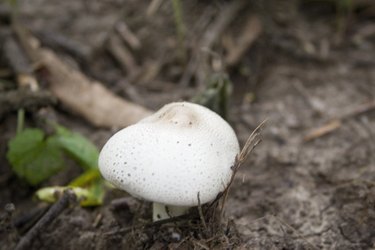
You can't talk about species of mushrooms without discussing fungi. Just like fruit to a plant, a mushroom is a reproductive structure for some forms of fungi. Instead of seeds, mushrooms produce millions of spores, too small to be seen with the naked eye, in the pores or gills under their caps. These spores are spread by animals who are feeding and by the wind; once they land, the spores form microscopic rooting threads known as mycelium that penetrate and feed on their new food sources. Once they have taken root, mushrooms can grow quite quickly.
Basic Mushroom Classification
Video of the Day
The terms mushroom and fungi are often used interchangeably when describing the above-ground, familiar fruiting body. There are about 14,000 known species of mushrooms, with five divisions (phyla) of fungi: Chytridiomycota, Zygomycota, Ascomycota, Basidiomycota and Glomeromycota. There are several orders within the classes of fungi that are also worth mentioning.
Video of the Day
The Agaricales order of fungi includes field mushrooms and familiar names like oyster, enoki and shiitake mushrooms. These generally have thin gills under their caps and stalks beneath. Those in the Boletales order have pores under their caps instead of gills. Fungi of the Polyporales order have tubes beneath their caps and can be found on dead or living trees.
Cantharelloid fungi mushrooms look more like cones, trumpets or clubs, with expanded tops and coarse ridges on the undersides and stalks. Clavarias fungi grow differently, more like coral or shrubs. Some have flattened, clustered branches that are close together.
How Fast Do Mushrooms Grow?
Different species of mushrooms grow at different rates, but as a general rule, they grow pretty quickly. Why is that? This is partly because, unlike plants and animals, mushrooms do not grow through cell division; instead, they grow via cell enlargement.
This allows them to puff up quickly, with little energy. They thrive on water and humidity and can grow from a small pinhead into a large, capped mushroom seemingly overnight.
Oyster mushrooms are the fastest-growing kind of fungi. Many gardeners enjoy growing mushrooms at home, and this is a good one to start with because you won't have to wait long for results. Generally speaking, it takes about one to two months to grow usable mushrooms from spores. This includes oysters, buttons and other common varieties.
Growing Mushrooms at Home
The best places to grow mushrooms are cool, humid and dark, like crawl spaces and basements. They can also be planted outdoors in vegetable gardens as long as the growing conditions are right. Make sure that the mushrooms are kept away from pets, too. Mushrooms need substrate to grow; this substance may be included with a kit, if that's what you have purchased, or you can make your own.
Before you begin growing mushrooms, research the species and find out what kind of substrate it prefers. Many experts recommend using a base of straw or sawdust, but you will need to add materials like nitrogen, calcium, sulfur, phosphorus and potassium. You can buy substrates that contain these. Look for those with pH levels from 5 to 6.5.
Finally, the substrate has to be pasteurized or sterilized to eliminate any competing bacteria or mold. While this process might seem complicated, there should be instructions in the mushroom or substrate kit, and it is fairly straightforward most of the time. Put the substrate into a large, clear plastic bag or a small container like a mason jar. It will now be ready for you to introduce the mushroom spores.
- Encyclopedia of Life: Mushrooms
- New World Encyclopedia: Mushroom
- Gmushrooms.com: Mushrooms: What is a Mushroom? Mushroom Facts
- Fungially: How Long Does it Take to Grow Mushrooms: Oysters, Shiitakes, and More
- Total Gardener: Magic vs Oyster vs Shiitake – How Long From Start to Finish?
- GroCycle: A Complete Guide to Mushroom Substrates